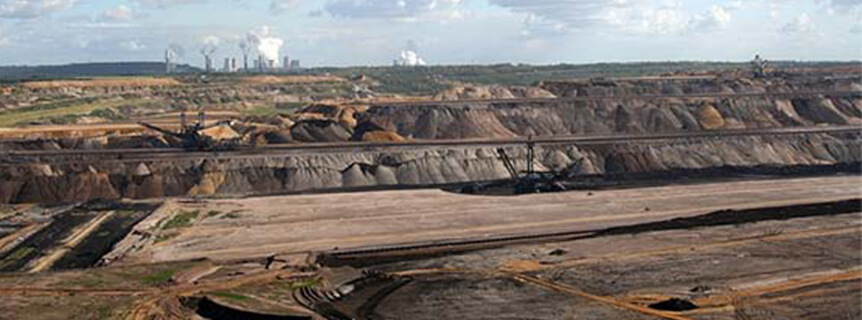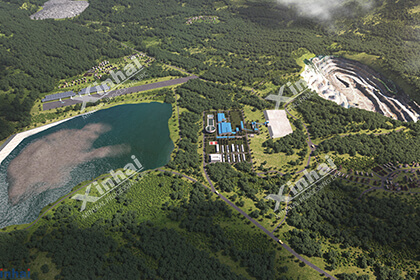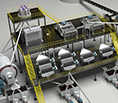Guide of Open-pit Mine Waste Dump
 Shirley
Shirley
 Mar 05, 2021
Mar 05, 2021
 1725
1725
If you want to know more details about equipment, solutions, etc, please click the button below for free consultation, or leave your requirements!

Waste dump, also known as waste rock yard, refers to the place where mining wastes from open-pit mines are concentratedly discharged. It is generally divided into internal waste dump and external waste dump. Internal waste dump refers to discharging the rock and soil into the goal of the open-pit mine directly, which is the most economical method of dumping. It is suitable for ore bodies with a mining depth of 30-50m and an inclination angle of less than 5-10°. External waste dump is the dump outside the open-pit mine boundary for stacking stripped materials, or other sites selected for stacking waste rock and soil.
This article will discuss the open-pit mine waste dump from the following aspects:
Waste dump site selection
Dumping methods choice
Waste dump closure
Waste dump reclamation
Waste dump common accidents and hazards
Waste dump safety precautions
Let’s drive in now!
01 Waste Dump Site Selection
BackIt should choose the wasteland on hillsides and valleys. Try not to occupy farmland and avoid moving villages.
Try to choose the site near the open stope, wellhead, and tunnel to shorten the transportation distance.
It should be ensured that it does not threaten the safety of stopes, industrial sites, residential areas, roads, farming areas, waters, tunnels, etc.
The site selection should have reliable geological data and the mine waste dump site shouldn’t be built in areas where geological disasters may occur.
For the dumping site built on the hillside, all the Slope vegetation and the quaternary weak layer should be removed and cut into stepladder to enhance the friction of the base and improve the stability.
The mine waste dump cannot affect the normal mining and slope stability of the mine. There should be a certain safe distance between the dump slope foot and the ore body mining point.
The total volume of dumping should be compatible with the designed total stripping volume.
It should be chosen in the leeward zone of the residential area as far as possible to prevent dust pollution of residential areas and prevent harmful components from flowing into rivers and farmland.
When designing, you should consider the possibility of reclamation and make plans for reclamation
02 Dumping Methods Choice
Back(1) Dumping Method
According to the different transportation methods and dumping machinery of open-pit mines, the dumping methods can be divided into: automobile transport-bulldozer dumping, railway transportation-excavator dumping, dumping bood dumping, frontloader dumping and sealing-tape machine dumping.
(2) Development Trends and Requirements
Try to use high-efficiency dumping technology to improve the strength of dumping.
Increase the dumping capacity per unit area, increase the stacking height, and reduce the floor area of the dump.
Pay attention to the reclamation of the waste dump, reduce environmental pollution.
03 Waste Dump Closure
BackAt the end of the service life of the waste dump, the mining enterprise shall sort out the dump data and compile the dump closure report.
Waste dump data includes: waste dump design data, waste dump final plan, waste dump engineering geology and hydrogeology data, waste dump safety and stability evaluation data, waste dump reclamation planning data, etc.
Waste dump closure report includes: waste dump layout plan at the end, waste dump safety and stability evaluation report at the end, waste dump reclamation planning data at the end, etc.
Before the dump is closed, the intermediary service agency shall conduct the safety and stability evaluation. If it does not meet the safety conditions, the evaluation unit should propose governance measures. The enterprise shall govern as required and report to the safety production supervision and management department above the provincial level for review
After the mine waste dump is closed, the original enterprise shall be responsible for the safety management. For the waste dump site closed by bankrupt companies, the local government should designate the unit or enterprise to manage it.
When the closed dump site is reopened or used for other purposes, it shall undergo feasibility design demonstration and report to the safety production supervision and management department for review and approval.
04 Waste Dump Reclamation
BackDuring the production of the waste dump, mining enterprises should formulate feasible reclamation plans. The bench that reaches the final mining boundary can be reclaimed first.
The waste dump reclamation planning should include site preparation, topsoil collection and matting, overburden thickness, and selection of suitable growing plants.
If the closed mine waste dump has not been reclaimed or not fully reclaimed, sufficient funds for reclaiming should be reserved.
05 Waste Dump Common Accidents and Hazards
BackCommon accidents at waste dumps are divided into three categories: waste dump landslides (collapses), waste dump mudslide, and waste dump environmental pollution.
(1) Waste Dump Landslides (Collapses)
The design and construction of the waste dump site were not well considered in the early stage. Insufficient attention, no engineering geological exploration of the dump, many aspects related to the construction quality of the dump in the design are ignored, and incomplete cleaning of the soft layer at the bottom will leave hidden dangers of landslide.
The dumping in production is not scientific and the dumping is not organized strictly according to the design requirements. For example, the thickness of the hydrophobic blocks at the bottom is not enough, and the rock and soil are usually discharged mixed, artificially forming a weak surface inside the dump. With the increase in the height of waste rock accumulation in the dump, when the shearing strength exceeds the critical shear stress, the landslide will occur along this weak surface.
(2) Waste Dump Mudslide
a) Waste Dump Mudslide Classification
Mine mudslide can be generally divided into hydrodynamic mudslide and gravitational mudslide according to its cause.
The hydrodynamic mudslide is formed because a large number of loose solid materials are piled up in the valley area with large catchment area and flow rapidly along the steep slope topography under the action of hydrodynamic scouring. It is mainly formed by the influence of the developed surface water system.
The gravitational mudslide is formed because the water-absorbing rock and soil soften with water, when the water content reaches a certain level, it turns into viscous fluid. It may also be transformed into mudslide from collapse or landslide mass.
b) Waste Dump Mudslide Causes
Three basic forming conditions for mudslide:
The mudslide area is rich in loose rock and soil.
The slope is steep and has large longitudinal slope gully bed.
The upper and middle reaches of mudslide area have large catchment area and sufficient water source
(3) Waste Dump Environmental Pollution
Under the effect of wind, the mine waste dump produces a large amount of dust, which blows up with the wind, affecting the health of workers, causing harm to the surroundings, polluting the air, polluting farmland, and affecting the quality and harvest of crops.
Water and soil erosion causes water pollution and affects the ecological environment.
06 Waste Dump Safety Precautions
BackThe hydrogeology and engineering geology exploration of the waste dump should be done well.
Pay attention to the construction quality of the waste dump. The foundation cleaning should be thorough, the benches should be standardized and do not leave future trouble.
Constructing and improving the drainage facilities of the waste dump. Drain the atmospheric precipitation, pre-build seepage dikes, repair drainage ditches, control the bulldozing order, and avoid the formation of weak interlayers.
Improving the dumping process.
Building protective wall. Piling hard large rocks on the bottom layer can stabilize the foundation and facilitate drainage, control the bulldozing order, and avoid forming weak interlayer.
Control the environmental pollution of waste dump. You can use biological treatment measures to prevent dust and soil erosion in the waste dump, such as vegetation. In addition to preventing rainwater from penetrating into the interior, it can also absorb a lot of water. Building the barrier dams to form sludge sand sedimentation tanks can also protect soil erosion and prevent pollution of farmland and water systems.
The waste dump should be tested and analyzed every 5 years by a qualified intermediary agency.
When the dump operation is carried out, the danger area should be delineated and warning signs should be set up. Irrelevant personnel should not enter the danger area. No one should pick ore, stone or do other activities in mining area or danger area of the dump.
During mine construction, waste rock from roads and industrial sites should be centrally discharged in an appropriate location rather than dumped on the side of roads and industrial sites to avoid mudslide.
07To Wrap Up
BackThe above introduces the planning of the open-pit waste dump in detail from waste dump site selection, dumping methods choice, waste dump closure, waste dump reclamation, waste dump common accidents and hazards and waste dump safety precautions. It is recommended that all mining owners make the corresponding waste dump plans in advance to reduce the hazards and maximize mine benefits.
If you have different ideas, questions or want to purchase mining equipment, please submit a message or consult our online customer service. We will contact you as soon as possible.
 +86 13810565920
+86 13810565920 xlyin@xinhaimining.net
xlyin@xinhaimining.net




 Message
Message Chat Now
Chat Now




















